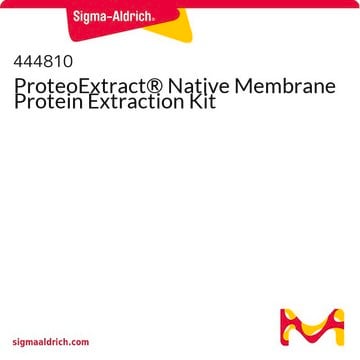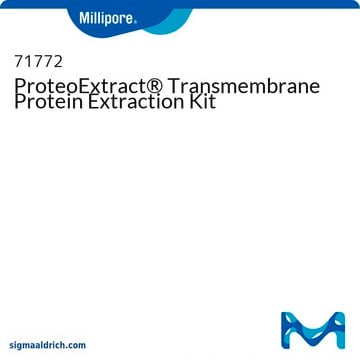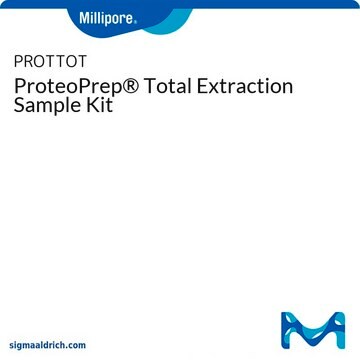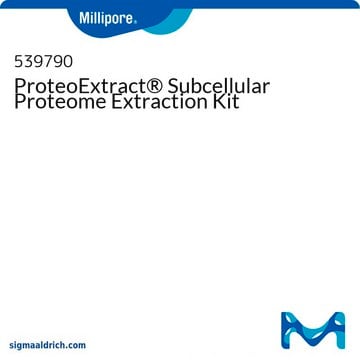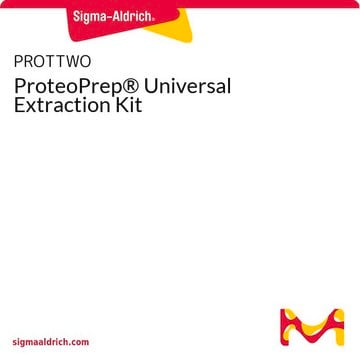Recommended Products
storage temp.
2-8°C
General description
ProteoPrep® Membrane Extraction Kit reagents utilize a powerful detergents for higher loading and resolution of proteins in 2D gels. Protein Extraction Reagent Types 3 and 4 are optimized for proteomic studies. Extraction reagents 3 and 4 are ideal for protein extraction prior to isoelectric focusing and 2D electrophoresis. This kit also includes reagents for the reduction and alkylation of disulfide bonds. The ProteoPrep® Membrane Extraction Kit was designed through a collaboration of Proteome Systems and Sigma research scientists.
Application
ProteoPrep® Membrane Extraction Kit is designed to prepare highly enriched membrane protein solutions from many types of cells. The final protein solution are suitable for 2D gel electrophoresis.
Features and Benefits
- Innovative detergent preparations - Improved solubility allows for higher protein loads and greater visibility of low abundance proteins in 2D gels.
- Two pre-mixed solubilization solutions - Removes interfereing non-membrane proteins prior to extractions, resulting in uncluttered 2D arrays.
- Pre-measured reducing & alkylating reagents - Easy-to-use reagents provide improved IEF resolution.
Legal Information
ProteoPrep is a registered trademark of Merck KGaA, Darmstadt, Germany
Signal Word
Danger
Hazard Statements
Precautionary Statements
Hazard Classifications
Acute Tox. 3 Oral - Aquatic Chronic 2 - Carc. 2 - Eye Dam. 1 - Repr. 1B - Resp. Sens. 1 - Skin Corr. 1A - Skin Sens. 1 - STOT SE 3
Target Organs
Respiratory system
Storage Class Code
6.1C - Combustible acute toxic Cat.3 / toxic compounds or compounds which causing chronic effects
Flash Point(F)
186.8 °F - closed cup
Flash Point(C)
86 °C - closed cup
Certificates of Analysis (COA)
Search for Certificates of Analysis (COA) by entering the products Lot/Batch Number. Lot and Batch Numbers can be found on a product’s label following the words ‘Lot’ or ‘Batch’.
Already Own This Product?
Find documentation for the products that you have recently purchased in the Document Library.
Customers Also Viewed
Lili Xu et al.
The Journal of general virology, 90(Pt 11), 2695-2703 (2009-07-25)
Raccoon dog is one of the suspected intermediate hosts of severe acute respiratory syndrome coronavirus (SARS-CoV). In this study, the angiotensin-converting enzyme 2 (ACE2) gene of raccoon dog (rdACE2) was cloned and sequenced. The amino acid sequence of rdACE2 has
Sreepriya Nair et al.
Electrophoresis, 32(24), 3621-3629 (2011-11-22)
Performing 2-DE of lipid-rich multilamellar membranes like myelin is a cumbersome task. However, for understanding its molecular organization and changes during diseases, identification of proteins of myelin is essential. Although the 2-D-proteomic approach of myelin has been employed to understand
Medicharla Venkata Jagannadham et al.
Journal of proteomics, 75(8), 2488-2499 (2012-03-16)
Antarctic bacteria are adapted to the extremely low temperature. The transcriptional and translational machineries of these bacteria are adapted to the sub-zero degrees of temperature. Studies directed towards identifying the changes in the protein profiles during changes in the growth
Ji Youn Lim et al.
Applied and environmental microbiology, 73(7), 2037-2047 (2007-02-06)
Escherichia coli O157:H7 causes hemorrhagic colitis and hemolytic-uremic syndrome in humans, and its major reservoir is healthy cattle. An F-like 92-kb plasmid, pO157, is found in most E. coli O157:H7 clinical isolates, and pO157 shares sequence similarities with plasmids present
Haiqing Sheng et al.
Applied and environmental microbiology, 74(16), 5015-5022 (2008-06-17)
Escherichia coli O157:H7 causes hemorrhagic colitis and the life-threatening hemolytic-uremic syndrome in humans and transiently colonizes healthy cattle at the terminal rectal mucosa. To investigate the role of the O antigen in persistence and colonization in the animal host, we
Our team of scientists has experience in all areas of research including Life Science, Material Science, Chemical Synthesis, Chromatography, Analytical and many others.
Contact Technical Service